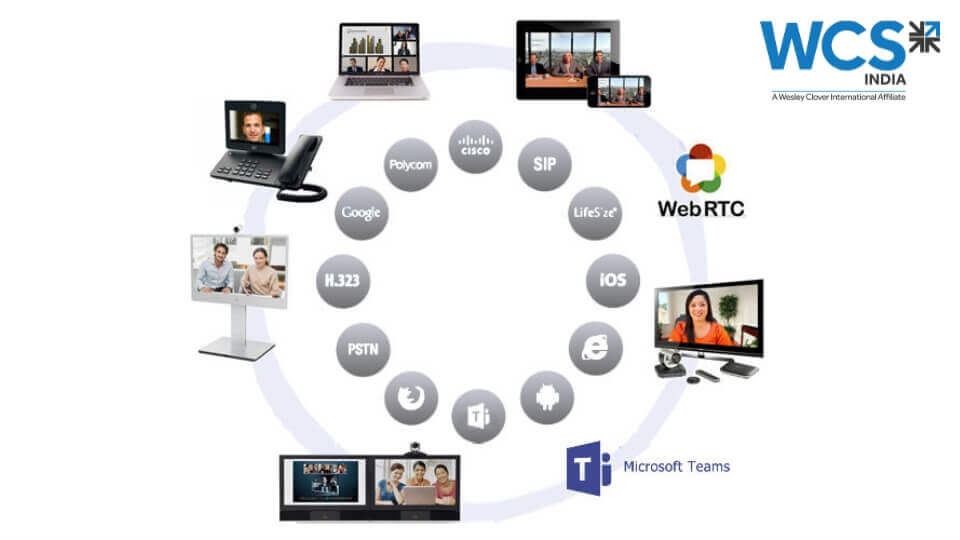What is Video Conferencing Interoperability and why you should Focus on it for Success?

The innovation is up in the air of video conferencing. The boost in efficiency, the improved QoS, and optimal throughput have become the deliverables. Irrespective of the city, town, or any remote location, every representative is getting connected with one another easily. The technology of video conferencing is breaking every wall and collaborating the entire world exquisitely.
As reported by Nemertes’ “Visual Communications and Collaboration: 2018-19 Research Study” of above 500 organizations in Asia, Europe, and North America:
More than 75% of the executives had already deployed or made plans to deploy the video conferencing systems into their meeting spaces- huddle or boardroom meetings. Even 81.1% were already holding it up or were planning to support the desktop video conferencing.
And, the interoperability has evolved to remove the barriers of dissimilar VC devices, systems, and platforms in a boardroom/ meeting room.
What is Video Conferencing Interoperability?
Video Conferencing Interoperability is a tech-defined advanced way to connect better.
If you are using a Polycom device, and the other participant is using Cisco or any other device etc. then, with VC interoperability, the members of both sides can connect easily. This technology lets the participants enjoy mixed environments hassle-free.
Technically, it means that two individual VC systems, which are running on the same technology wavelength, are interoperable and they can work altogether, despite the systems they employ.
Coming to the video conferencing interoperability, it can be categorized into two, as:
1. Multi-Vendor Interoperability:
It is the most prominent aspect of interoperability, as the VC system may ditch you if you and other participants are using the applications of different vendors. Therefore, this feature comes in that bridges the gap among multiple vendors and allows them to connect and collaborate effortlessly. Regardless of the platform, the participants are employing in the video conferencing meeting, they can enjoy this feature with no requirement of additional MCU hardware.
2. Multi-Device Interoperability:
The second challenge is of using different devices during the meeting. The multi-device interoperability overcomes this hurdle by providing the ease of usage on any device. You can access the VC meeting through web browsers, mobile devices, any software, or the room system, irrespective of which device the other members are using in the same meeting. This will also let the participants enjoy the features, as- content sharing, in-meeting chat, and other meeting customization alternatives.
Wondering, whether the interoperability is doing something profitable for the business or not? Have a look at the below research, which is conducted by Nemertes. It is the “Workplace Collaboration: 2019-20 Research Study” of above 625 enterprises in Asia, Europe, and North America. It is:
Around 31% of the meeting representatives have already incorporated the Meeting Interoperability Service, whereas the other 34% are planning to use it by the end of this year, 2019, or are assessing the services/ applications for its probable future deployment.
Free Download: Discover how you can communicate face-to-face with our super-convenient video solutions.
Benefits of Video Conferencing Interoperability
If you are among those 75% (discussed before in this blog), then you must integrate this technology into your business strategies. It’s true that a significant percentage of those representatives, who are using this application (coupled with video, voice, & content sharing), are enjoying a notable amount of benefits, as:
- Keeping the legacy investments preserved, along with the decrease in cost in the meeting room systems
- Reducing the complexity of connecting the devices to other devices. No more mesh of dissimilar video conferencing devices!
- Allowing easy content sharing facility to each of the participants of the VC meeting
- Providing the persistent & enriching user experience in a conference room or on the computer systems
In short- This is the time when the IT leaders have to give serious thought towards video conferencing interoperability (if it’s not the member of their VC meetings till now). They should assess the integration platforms that:
- Enable easy-to-connect collaboration with participants, despite using different devices; and
- Allow the assets’ security of already existing VC endpoints
Final Thoughts
Video Conferencing Interoperability is the best-of-the-breed technology that is giving a success ladder to the organizations. It helps them touch the pinnacle of productivity and maximum efficiency.
Polycom, BlueJeans, Lifesize... It doesn’t matter which solution you and other associates choose; the video conferencing interoperability lets you enjoy a seamless meeting experience.




